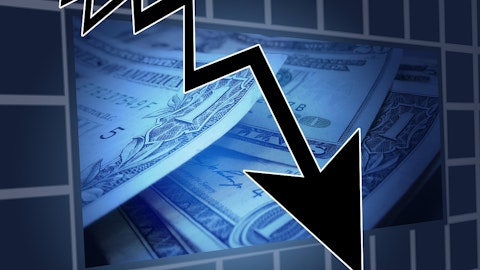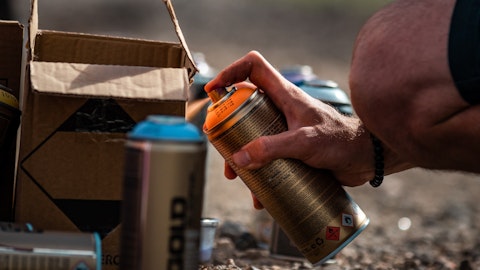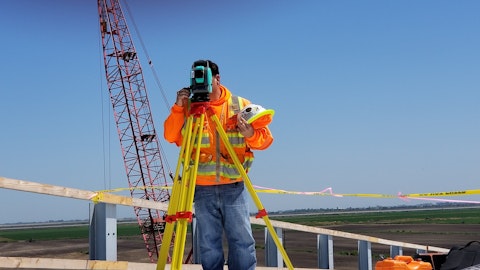RPM International Inc. (NYSE:RPM) Q1 2024 Earnings Call Transcript October 4, 2023
RPM International Inc. beats earnings expectations. Reported EPS is $1.64, expectations were $1.56.
Operator: Good morning, and welcome to the RPM International Fiscal First Quarter 2024 Earnings Conference Call. [Operator Instructions] Please note this event is being recorded. I would now like to turn the conference over to Matt Schlarb, Senior Director of Investor Relations. Please go ahead.
Matt Schlarb: Thank you, Andrea, and welcome to RPM International’s conference call for the fiscal 2024 first quarter. Today’s call is being recorded. Joining today’s call are Frank Sullivan, RPM’s Chairman and CEO; Rusty Gordon, Vice President and Chief Financial Officer; and Michael Laroche, Vice President, Controller and Chief Accounting Officer. This call is also being webcast and can be accessed live or replayed on the RPM website at www.rpminc.com. Comments made on this call may include forward-looking statements based on current expectations that involve risks and uncertainties which could cause actual results to be materially different. For more information on these risks and uncertainties, please review RPM’s reports filed with the SEC.
During this conference call, references may be made to non-GAAP financial measures. To assist you in understanding these non-GAAP terms, RPM has posted reconciliations to the most directly comparable GAAP financial measures on the RPM website. Also, please note that our comments will be on an as-adjusted basis and all comparisons are to the first quarter of fiscal 2023, unless otherwise indicated. We have provided a supplemental slide presentation to support our comments on this call. It can be accessed in the Presentations and Webcasts section of the RPM website at www.rpminc.com. Additionally, as we discussed on our most recent earnings call, certain businesses in Asia-Pacific that were previously part of the Construction Products Group are now being managed and reported under the Performance Coatings Group effective June 1, 2023.
As a result, all references to CPG and PCG today reflect the updated structure. The recast businesses generate approximately $100 million in annual sales, and this change has no impact on consolidated results. At this time, I would like to turn the call over to Frank.
Frank Sullivan: Thank you, Matt, and thank you to everyone for joining us on our call today. I’ll begin today’s call with an overview of our first quarter performance and then I’ll turn the call over to Mike Laroche to discuss financials in more detail. Then Matt Schlarb will provide an update on one of our businesses. And then Rusty Gordon, our CFO will cover our outlook for the next quarter and the balance of fiscal ’24. At the conclusion of the prepared remarks, we’ll be pleased to answer your questions. Beginning on Slide 3 of our investor deck. Our associates are, to put it simply, executing at a very high level. We generated 4.1% sales growth in what can be best described as a mixed economic environment resulting in record first quarter sales.
Driven by the continued execution of our MAP 2025 initiatives, we expanded margins and grew adjusted EBIT by 12.3% to an all-time quarterly record. These results represent the seventh consecutive quarter of record sales and adjusted EBIT. Importantly, we remain focused on converting this profitability into cash flow, and this focus resulted in $359.2 million of cash generated from our operating activities during the quarter, which is an all-time record. Moving to Slide 4. Sales were driven by pricing, mainly from the wraparound effect of increases implemented in fiscal 2023 and strong unit volume growth in our Construction Products Group. Our CPG was our fastest-growing segment as the team there leveraged its strategic focus on repair and maintenance and differentiated turnkey service model.
As we’ve highlighted in the past, several of our businesses in our Performance Coatings Group and Construction Products Group have positioned themselves to benefit from spending on infrastructure and reshoring capital projects, which continued during the quarter. The successful execution of our MAP 2025 initiatives led to margin expansion during the quarter, particularly in businesses where volumes grew as we were able to more fully leverage the structural efficiency improvements that we put into place. MAP 2025 was a key driver in growing adjusted EBIT to an all-time record of $309 million. As I mentioned, this growth is in addition to strong results in the prior year. And our two-year stack sales and adjusted EBIT growth rates were 22% and 49%, respectively.
MAP 2025 initiatives are also contributing to structural improvements in working capital. Through improved coordination between sales operations, procurement and R&D as well as being a more data-driven decision-making organization, we have become more agile with more efficient inventory processes. This contributed to strong cash flow conversion during the quarter. While we still have significant work to do in improving in this area, I’m proud of the progress we are making on a sustainable basis. Looking at sales by geography on Slide 5. Sales growth was strongest in Africa, the Middle East and Latin America, driven by continued spending on infrastructure projects in these emerging markets. This growth is in addition to strong prior year results when sales in these regions were up double-digits.
Europe is expanding for the first time in over a year, while economic growth in the region remains subdued, our teams captured growth opportunities and are leveraging MAP 2025 initiatives to expand margins. While on the surface, sales growth in North America may appear moderate, it is important to keep in mind that in the prior year revenues increased in North America and nearly 23%. The two-year stack growth rate in North America is 26.1%. Overall, RPM has begun our fiscal year with positive momentum and our teams are executing at a high level on the things that we can control. We remain focused on executing our MAP 2025 program, leveraging our competitive strengths to capture growth opportunities, and bringing new products to market to continue growing throughout the fiscal year.
I’d now like to turn the call over to Mike Laroche to cover our financial results in more detail.
Michael Laroche: Thanks, Frank. Starting on Slide 6. Consolidated sales increased 4.1% to a first quarter record $2.01 billion, driven by pricing with modest volume growth. Organic sales increased 3.9% with foreign currency translation and acquisitions less divestitures, both contributing 0.1% to sales. Adjusted EBIT grew by 12.3% to an all-time record of $309 million during the quarter. Gross margin expansion was the driver of this growth, led by MAP 2025 initiatives and improved fixed-cost utilization, particularly at businesses with growing volumes. All segments, except Consumer, generated commodity cycle benefits. Because of Consumer’s raw material basket and in particular TiO2 in metal packaging, this segment’s raw material inflation has been larger and continued longer than the other segments.
SG&A as a percentage of sales increased during the quarter, driven by growth investments and higher variable compensation expenses due to the improved financial performance. Expense reduction actions were implemented in the fourth quarter helped to offset the SG&A increase. Adjusted EPS grew 11.6% to $1.64, and was driven by adjusted EBIT growth. Turning to the segment results on Slide 7. Our Construction Products Group achieved all-time record sales of $783 million, an increase of 10.8% from the prior year period. Organic sales growth was 9.5% with acquisitions contributing 0.6%, and foreign currency translation adding 0.7% to sales. Sales growth was led by strength in our restoration systems for roofing, facades and parking structures, which benefited from the segment’s strategic focus on repair and maintenance as well as its differentiated turnkey service model.
Concrete admixtures and repair products also helped drive sales growth. After several quarters of sales declines, Europe returned to growth. As expected, new office construction was weak, but stronger demand in other end markets and our strategic focus on repair and maintenance more than offset this softness. Adjusted EBIT increased 33% to an all-time record $145 million, led by improved fixed cost leverage and MAP 2025 benefits, including commodity cycle benefits. As a result of improved financial performance, variable compensation increased and was partially offset by expense reduction actions put in place at the end of fiscal 2023. Additionally, as we recently announced, in the second quarter of fiscal 2024 CPG acquired a wall system fabricator to expand its offering in offsite panelized construction.
The acquired business has annual sales of approximately $20 million. On Slide 8, the Performance Coatings Group achieved record net sales and adjusted EBIT. Revenue increased 4.1% to a record $379 million. Organic sales grew 4.0%, acquisitions added 0.8% and foreign currency translation was a 0.7% headwind. Sales were driven by strong demand for the segment’s flooring systems and other engineered solutions for infrastructure and reshoring capital projects. Demand was strong internationally and increased pricing also contributed to growth. Adjusted EBIT increased 17.4% to an all-time record of $59 million. The growth was driven by strong sales and MAP 2025 benefits, led by commercial excellence programs in Europe and included commodity cycle benefits.

Copyright: chamillewhite / 123RF Stock Photo
These results are on top of a strong prior-year increase. Part of our MAP 2025 focus on improving profitability in Europe, PCG divested a non-core service business there. PCG incurred $14.6 million of charges related to this divested business, which are excluded from adjusted EBIT. Moving to the next slide, Specialty Products Group sales declined 10.7% to $181 million, organic sales declined 9.0%. Divestitures, net of acquisitions, reduced sales by 2.2%, and foreign currency translation was a tailwind of 0.5%. OEM demand was weak during the quarter, particularly in businesses that serve the residential sector, including coatings for furniture, doors, windows and cabinets. Additionally, SPG sales were negatively impacted by customers holding inventory levels below historical averages, which is pressuring volumes.
The divestiture of the non-core furniture warranty business last fiscal year also reduced sales. Pricing helped to partially offset some of this weakness. SPG adjusted EBIT declined 39.6% to $18 million. The sales decline, product mix and unfavorable fixed cost leverage drove the decline. The divestiture of the non-core furniture warranty business also contributed to the adjusted EBIT decline. SG&A as a percentage of sales increased, driven by investments in growth initiatives and unfavorable impact of deleveraging a lower revenue. Expense reduction actions implemented at SPG in Q4 helped to offset this. Moving to Slide 10, the Consumer Group sales increased 1.5% to a first quarter record of $670 million. Organic sales increased 1.7%, foreign currency translation was a headwind of 0.2% and there was no impact from acquisitions.
The sales growth was driven by increased pricing, primarily due to the large increase instituted during the first quarter of 2023 in response to inflation. Inflation, although less of a headwind, still persisted for the Consumer segment in the first quarter. As a reminder, Consumer faced the challenging prior year comparison as sales surged 22.5% in the first quarter of 2023, when it began restocking retailers after raw material — raw material availability improved. Volumes declined moderately driven by reduced customer takeaway and certain customers holding inventory levels below historical averages. Share gains helped to partially offset these volume pressures. Adjusted EBIT increased 3.5% to $121 million, driven by MAP 2025 benefits and the sales increase.
Cost inflation continued in the quarter and was a headwind to adjusted EBIT as was lower fixed cost utilization as we slowed production to normalize inventories. We also received a $10.3 million business interruption insurance reimbursement during the first quarter. And the gain associated with this reimbursement has been excluded from adjusted EBIT. Now I’d like to turn the call over to Matt to go over the balance sheet and cash flow, and provide a business update.
Matt Schlarb: Thank you, Mike. Moving to Slide 11. The progress we made improving working capital during the fourth quarter continued in the first quarter driven by our inventory normalization actions and MAP 2025 initiatives to structurally improve working capital. Inventories declined by $223 million compared to the first quarter of 2023. Working capital management and strong profitability growth resulted in an all-time record cash flow from operating activities of $359 million compared to $24 million in the prior year. This enabled us to return $54 million to shareholders through dividends in the first quarter. We have continued our share repurchase program and have bought back $25 million of shares from the beginning of the fiscal year through the end of September.
We also reduced debt by $178 million during the quarter. Now, turning to Slide 12, we’d like to provide an update on Pure Air, the indoor quality and HVAC service business that CPG acquired in fiscal 2022. Pure Air provides turnkey solutions to address indoor air quality and HVAC performance issues. These include environmental consulting, building diagnostics and HVAC system cleaning and restoration. As commercial HVAC systems age, they can become dirty and worn down, resulting in reduced performance, efficiency and air quality. These issues negatively impact all buildings that can become critical problems in places like hospitals and schools, which are key end markets for CPG. Pure Air’s turnkey solutions address these challenges and offer building owners the possibility of restoring their HVAC equipment instead of replacing it, resulting in significant savings and reduced disruption to the building’s occupants.
Pure Air expand CPG’s role as a partner to building owners, offering products and services focused on the repair, maintenance and restoration of all six sides of a building, which drives increased efficiency, extended asset life, and lower costs. Sales over the last 12 months are more than double what they were when Pure Air joined RPM, and we are optimistic about its future. Now I’d like to turn the call over to Rusty to cover the outlook.
Rusty Gordon: Thanks, Matt. Our outlook for the second quarter is on Slide 13. Many of the trends we experienced in the first quarter are expected to continue into the second quarter. On the positive side, the tailwinds include MAP 2025 including the commodity cycle, infrastructure and reshoring demand, reduced destocking, and resilient demand for repair and maintenance. As a reminder, some of our MAP 2025 benefits are more dependent on volumes to be fully realized. So they will naturally be lower in our seasonally lower-volume quarters of Q2 and Q3, and higher and stronger volume quarters, Q4 and Q1. Some of the challenges we expect to face in the second quarter are continued weakness in OEM demand, softness in some new construction end markets, and a reduced benefit from pricing, although pricing is still expected to be positive.
We also faced challenging comparisons to the prior year when sales grew 9% and adjusted EBIT increased by 36%. Taking all of this into account, we are forecasting sales to increase in the low-single-digit range on a consolidated basis, led by CPG and PCG with specialty still showing declines. We expect adjusted EBIT margins to expand and to generate consolidated adjusted EBIT growth of high-single-digits to low-double-digits. Moving to Slide 14. Turning to our full year outlook, we still expect modest economic growth. Despite the soft macro backdrop, we are focused on leveraging the growth drivers we control including, number one, MAP 2025; number two, our strong position serving infrastructure and reshoring demand with our engineered solutions; and number three, our strategic focus on repair and maintenance.
We also continue to expect to benefit from reduced inflation, reduced destockings and easier comparison in the second half of the year. As was the case last quarter, we anticipate weakness in certain new construction markets throughout the year and weakness in OEM demand, at least in the first half of the year. Our current outlook for 2024 on a consolidated basis remains unchanged. Sales are expected to increase in the mid-single-digit range, with adjusted EBIT growing in the low-double-digit to mid-teen range. This concludes our prepared remarks. We are now pleased to answer your questions.
See also 40 Most Visited Cities in the World in 2023 and Top 15 Safest African Countries To Do Business.
Q&A Session
Follow Rpm International Inc (NYSE:RPM)
Follow Rpm International Inc (NYSE:RPM)
Operator: [Operator Instructions] And our first question comes from Mike Harrison of Seaport Research Partners. Please go ahead.
Frank Sullivan: Good morning, Mike.
Mike Harrison: Hi. Good morning. Congrats on a nice start to the year.
Frank Sullivan: Thank you.
Mike Harrison: It seems like the Construction business was pretty strong across the board. Just curious, where are you expecting to see momentum continue? Where could we potentially see some choppiness? And can you breakdown the 9.5% organic growth between volume and pricing?
Frank Sullivan: Sure. So boy, two-thirds to three quarters of their growth in the quarter was unit volume growth, and it was pretty strong at the Tremco Roofing WTI business at our Tremco Sealants business, Euclid. And then broadly, and this is mostly our Construction Products Group and our Performance Coatings Group in the Southern Hemisphere developing countries. And so real good strength there. In many instances, we’re bucking trends. As we talked about in the past, we’ve had a real focused effort on investing in growth initiatives. And one of the real starts this year is something that in this quarter that Matt talked about, which is Pure Air, which is finally gaining some traction after its first year, which we got off to a slow start.
Had to integrate it into WTI and into our Roofing sales force, and it’s going very well. So that’s one example of some of the very specific initiatives that we’re investing in that’s starting to pay off that’s, I think, allowing us to buck some of the trends in the construction markets.
Mike Harrison: All right. And then over on the Specialty business, you mentioned that you’re seeing weak demand from OEM customers, and it seems like that’s going to continue into the November quarter. But any thoughts on what that business looks like once it stabilizes? Maybe talk a little bit about your longer-term growth and margin expectations for that Specialty segment.
Frank Sullivan: Sure. So the biggest impact there is housing. We do a lot of wood stains and finishes into furniture, into windows and doors, kitchen cabinets. And so, notwithstanding the inventory mismatch for demand, particularly in this higher interest rate environment, the North American housing market, U.S. housing market is weak and continues to be weak, and that’s hurt us. Some other categories that they have been strong in, including manufactured housing and/or RVs. And those are weak after the post-COVID bump. All that notwithstanding, we have some very targeted initiatives in our Kop-Coat adjuvant business. There’s some patented products there that allow for a significant reduction in the use of herbicides and pesticides.
We believe in the long-term benefit of that business, and we’re investing in that. We’re investing in an expanding MRO channel for our Legend Brands business that should take out some of the storm-related cyclicality. Those are just a few examples. And, the one thing that the lower volume is hiding is some significant MAP 2025 improvements in our Specialty Products Group. But as Rusty highlighted, most of these improvements are on the manufacturing floor and/or cost price mix items. And with improved conversion cost, better handle on mix, those benefits only show up when we sell something. And so the lower volume is hiding, I think, the good efforts in our Specialty Products Group folks have made, along with the rest of RPM and executing on the MAP ’25 initiative.
Mike Harrison: All right. Thank you very much.
Frank Sullivan: Thanks, Mike.
Operator: The next question comes from Ghansham Panjabi of Baird. Please go ahead.
Frank Sullivan: Good morning, Ghansham.
Ghansham Panjabi: Good morning, Frank. Good morning, everybody. Thanks for fitting me in. I guess as a follow-up to the last question on construction and the margin improvement that you saw there. Frank, you highlighted several factors, fixed cost improvement, raw materials, MAP savings, et cetera. How would you have us think about those dynamics from a stack rank standpoint in terms of the margin bridge year-over-year?




